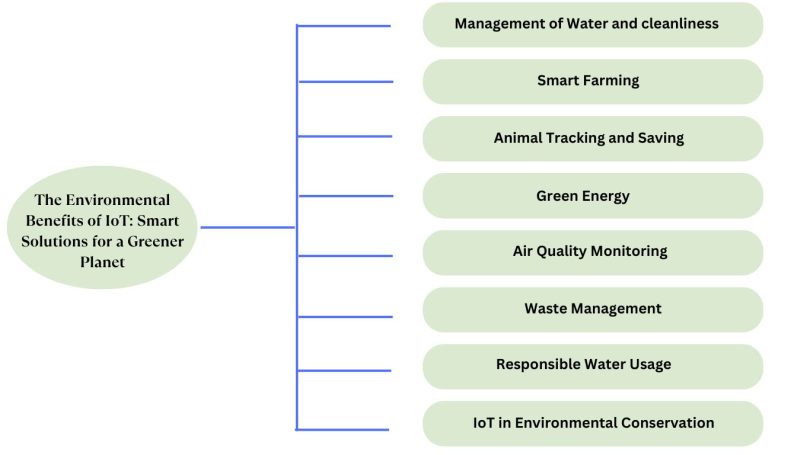The Earth is experiencing several challenging environmental issues including “climate change”, “air and water pollution”, “deforestation”, and loss of “biodiversity”, therefore, it is high time that we look for ways of protecting the environment.
The introduction of the IoT has seen the introduction of many smart devices that enhance distinct and innovative ways of monitoring, curbing and managing the surroundings.
IoT puts out a wealth of information that if analyzed can assist companies and organizations in enhancing their sustainability and environmental impact. Connectivity, data and cloud in IoT assist in real-time analysis of data to make an informed decision and action in the area of resource, wastes and energy use by makers of devices.
Advantages of Environmental Protection:
Management of Water and cleanliness:
Water usage equipment and water purification entails the use of sensors which are used to monitor and record data on factors such as the “pH”, “dissolved oxygen” and “temperature” of the water in systems such as lakes and rivers. Such data is most appropriate when it comes to establishing which areas require attention in terms of water pollution and how the issue should be dealt with. As well required are the waterway cleaning tools and types of equipment that aid in flushing out litter and other waste hence reducing water pollution and also are useful in the process of accumulating information about the state of the water bodies.
Smart Farming:
Smart farming technology entails the use of sensors that help to capture information on several factors within the environment where crops are grown including “temperature”, “humidity” and “moisture”. The above information enhances yield and optimizes the use of resources including water and fertilizers with minimal impacts on the environment.
Animal Tracking and Saving:
Those are used in monitoring the motion and behavior of animals with their habitat in their natural habitats. These devices track migratory birds and their activities, aquatic animals such as whales and dolphins, wild animals like deer and bears etc. The information that is collected helps scientists establish the places where the animals live and how the animals interact with their environment to define and develop ways in which to preserve the animals and their respective homes.
Green Energy:
The green energy monitoring systems incorporate the use of sensors that are used to collect energy use, climate, renewable energy and occupancy data. It is applied to enhance the smart grids and the lighting systems to reduce wastage and increase energy consumption efficiencies. They enhance the supply of electrical energy through an increase or decrease in the amount of generated electricity to meet demands and weather conditions to carry power. Similarly, smart lighting systems utilize IoT capacity to turn the lights on and off based on the presence of the people, daylight and time, it saves tremendous amounts of energy.
Air Quality Monitoring:
Air quality stations have the capability of detecting pollutants like carbon monoxide, nitrogen dioxide, and particulate matter which makes it possible to have an idea of the quality of air on a given real-time basis. This data can be beneficial to the community to identify specific areas that are most affected by pollution, and in turn, the health of the people will be enhanced.
Waste Management:
One of the typical examples of intelligent waste management is the system based on IoT, which is the necessary equipment that has electronic sensors placed in the bins, which tell the state of being full to the waste management companies. Optimization of waste collection routes reduces Greenhouse gas emissions from waste collection vehicles and enhances municipal services like curbside composting.
Responsible Water Usage:
This enables the business entities and developers of the public works to efficiently recognize where water is being wasted, for instance through leakage. Smart meters provide information on the management of water and its use, which reduces the expenses incurred due to the improper utilization of water.
IoT in Environmental Conservation:
With this technology, the preservation of wildlife is promoted because vulnerable species are often checked and safeguarded in many countries.
Wireless sensors are applied by organizations to monitor endangered species and their environment without having to interfere with their natural habitats. These sensors also provide real information, for example, about the presence of poachers or any other negative impact from human beings. It offers a method of preserving the habitat of these animals, thus their protection is likely to continue in the future.
Final Thinking:
Nowadays the environment is under a lot of stress, however, IoT is a possible solution at the moment. It is an online data collector that is also comprehensive and records a lot of aspects such as air quality, movement of animals and many others; it enables making accurate decisions. There are many examples of IoT at work for a better world, such as smart farming that uses resources, monitoring pollution to find out the spots that need to be addressed first and many more. It should also be noted that IoT can be used to make more accurate predictions of when maintenance will be required and citizen learning can contribute more to designing a better future. With this technology, it would then be possible for each one of us to come into the fold and join hands in order to create a healthier world for all the generations to come.



